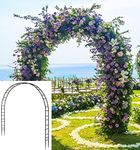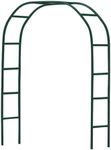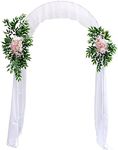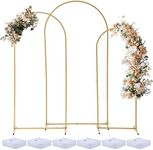Buying Guide for the Best Garden Arches
Choosing the right garden arch can transform your outdoor space, adding both beauty and functionality. Garden arches can serve as a focal point, support climbing plants, or create an inviting entrance to different areas of your garden. To find the best garden arch for your needs, consider the following key specifications and how they align with your garden's style, size, and purpose.MaterialThe material of a garden arch is crucial as it affects durability, maintenance, and appearance. Common materials include metal, wood, and plastic. Metal arches, such as those made from wrought iron or steel, are sturdy and can support heavy climbing plants but may require rust protection. Wooden arches offer a natural look and blend well with garden environments but need regular treatment to prevent rot and insect damage. Plastic arches are lightweight and low-maintenance but may not be as durable or aesthetically pleasing as metal or wood. Choose a material that complements your garden's style and consider the level of maintenance you are willing to undertake.
SizeThe size of the garden arch should be proportionate to the space where it will be placed. Consider both the height and width of the arch. Taller arches (over 7 feet) create a grand entrance and can accommodate larger climbing plants, while shorter arches (under 7 feet) are more subtle and suitable for smaller gardens. The width should be wide enough to allow comfortable passage; typically, widths range from 3 to 6 feet. Measure the area where you plan to install the arch to ensure it fits well and complements the surrounding landscape.
DesignThe design of a garden arch can significantly impact the overall aesthetic of your garden. Designs range from simple and modern to ornate and traditional. Simple designs with clean lines are ideal for contemporary gardens, while more intricate designs with decorative elements like scrollwork or lattice are perfect for classic or cottage-style gardens. Consider the existing style of your garden and choose a design that enhances its beauty and matches your personal taste.
StabilityStability is an important factor to ensure your garden arch remains upright and secure, especially in windy conditions or when supporting heavy plants. Look for arches with a solid base or those that can be anchored into the ground. Some arches come with ground spikes or brackets for added stability. If you live in an area with strong winds or plan to grow heavy climbing plants, opt for a more robust and stable arch to prevent it from toppling over.
AssemblyConsider the ease of assembly when choosing a garden arch. Some arches come in pre-assembled sections that require minimal effort to put together, while others may need more complex assembly. Check if the arch comes with clear instructions and all necessary hardware. If you are not comfortable with DIY projects, look for an arch that is easy to assemble or consider hiring someone to help with the installation.
PurposeThink about the primary purpose of the garden arch in your space. If you want it to support climbing plants, ensure it is sturdy enough to handle the weight and has features like trellis sides for plant support. If the arch is meant to be a decorative focal point, focus on design and material that enhance the visual appeal. For creating an entrance or pathway, consider the size and stability to ensure it serves its functional purpose effectively.






















